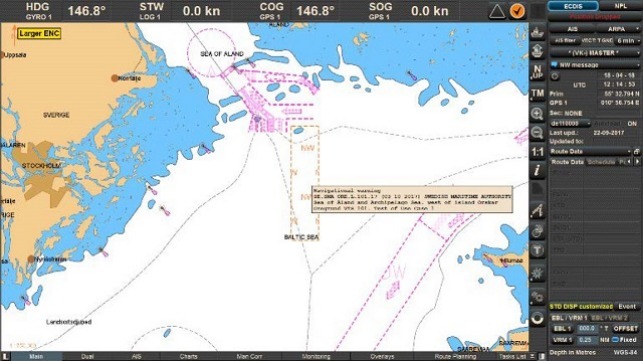STM Project Delivers Navigational Warnings Directly in ECDIS

The STM Validation project has released a new service to reduce crew workload and decrease the risk of accidents and misunderstanding. With the new Baltic Navigational Warning Service, navigational warnings can be sent directly to the ECDIS on board with digital communication machine to machine. The new service allows warnings to be sent only to those affected and to be deleted when no longer relevant, creating greater accuracy, relevance and less administrative burden and therefore leading to increased safety at sea.
The purpose with the Baltic Navigational Warning service is to provide the ship with only those warnings that are relevant for the route they are taking and for the time they are taking it. The warnings will be displayed directly in the ECDIS on board and automatically deleted when they are no longer valid.
The new service reduce workload on board, as there is no need to manually plot positions or areas received by Navtex or voice communication. It also reduce human error, as warnings are provided digitally and seamlessly shown directly in ECDIS. Possible human error, misunderstandings and manual plotting errors can be avoided.
Björn Andreasson is the Testbed Manager for the STM Validation project: “The new service is being verified by ships in the STM Validation project and also in the European Maritime Simulator Network. The mariners participating in the simulations were very positive. Not having to receive navigational warnings by Navtex only and manually transfer them was a great relief for the participants. An Officer on Watch said in the debriefing afterwards that he now could fully focus on safe navigation knowing that the navigational warnings of relevance would show up directly in the ECDIS on board.”
According to London P&I Club, insurance inspections regularly find deficiencies in managing navigation warnings and notices to mariners as officers fail to implement navigational safety notices. By providing the notices directly to ships ECDIS manual work and risk of missing important information is reduced.
The Navigational Warning Service has been developed within the STM Validation project, funded by the European Union and led by the Swedish Maritime Administration. The warnings are sent to the ships using the draft S-124 format. The S-124, navigational warnings, product specification is currently being developed by an IHO Correspondence Group. Before being mature for endorsement and standardization the STM Validation project serves as one of the testbeds to validate a draft version of the specification.
Malin Liljenborg at the Swedish Maritime Administration is participating in the International Hydrographic Organization's Sub-Committee on the World-Wide Navigational Warning Service. She sees a great potential for the international shipping world in the work being done today with Baltic Navigational Warnings: “The S-124 format present the information in a way that can be distributed by different means of communication allowing all types of navigational warnings to use this in the future.
Both the STM Validation project in the Baltic Sea region and the SMART Navigation project in Korea are working together to test this new format. The two projects gives us an opportunity to test the format at an early stage which is a great advantaged as we can use the experience in our continuous international work with improving navigational warnings globally.”
The products and services herein described in this press release are not endorsed by The Maritime Executive.
